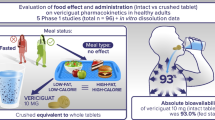Abstract
Purpose. To assess the bioequivalence of nadolol 40mg and 160mg tablets (Zenith-Goldline Pharmaceuticals) using Corgard® 40mg and 160mg tablets (Bristol-Meyers Squibb) as reference products, to estimate the effect of food in the gastrointestinal tract on nadolol bioavailability, and to evaluate the effectiveness of standard pharmacokinetic metrics AUCt, AUC∞, and Cmax in bioequivalence determinations.
Methods. Four bioequivalence studies were conducted as described in the FDA Guidance. Four additional studies of varying designs were conducted to establish bioequivalence of the 40mg tablet in terms of Cmax.
Results. Fasted and food-effect studies of the 160mg tablet clearly established bioequivalence and revealed an unexpected reduction in nadolol bioavailability from test and reference products in the presence of food. The food-effect study of the 40mg tablet (80mg dose) revealed a similar reduction in bioavailability from each product. Fasted studies of the 40mg tablet (80mg dose) established bioequivalence in terms of AUCt and AUC∞. However, Cmax criteria proved extremely difficult to meet in the initial 40mg fasted study because of the large variability, leading to additional studies and ultimately requiring an unreasonable number of subjects.
Conclusions. Final results clearly established bioequivalence of both strengths and characterized an unexpected food effect which did not appear to be formulation-related. However, the Cmax of nadolol is only slightly sensitive to absorption rate and the relatively large variability of Cmax reduces its effectiveness as a bioequivalence metric. Findings suggest that bioequivalence criteria for highly variable drugs should be reconsidered.
Similar content being viewed by others
REFERENCES
A. H. Jiminez, G. H. Tofler, X. Chen, M. E. Stubbs, H. S. Solomon, and J. E. Muller. Effects of nadolol on hemodynamic and hemostatic responses to potential mental and physical triggers of myocardial infarction in subjects with mild systemic hypertension. Amer. J. Cardiol. 72:47–52 (1993).
J. Bonelli, W. Waldhausl, D. Magometschnigg, J. Schwarzmeier, A. Korn, and G. Hitzenberger. Effects of exercise and of prolonged oral administration of propranolol on hemodynamic variables, plasma renin concentration, plasma aldosterone, and cAMP. Europ. J. Clin. Invest. 7:337–343 (1977).
R. A. Vukovich, J. E. Foley, B. Brown, D. A. Willard, M. Buckley, D. O'Kelly, D. Fitzgerald, W. Tormey, and A. Darragh. Effects of β-blockers on exercise double product. Brit. J. Clin. Pharm. 7:167S–172S (1979).
K. L. Duchin, R. A. Vukovich, L. G. Dennick, J. T. Groel, and D. A. Willard, Effects of nadolol β-blockade on blood pressure in hypertension. Clin. Pharmacol. Therap. 27:57–63 (1980).
J. Dreyfuss, D. L. Griffith, S. M. Singvhi, J. M. Shaw, J. J. Ross, R. A. Vukovich, and D. A. Willard. Pharmacokinetics of nadolol, a beta-receptor antagonist: Administration of single and multiple-dose regimens to hypertensive patients. J. Clin. Pharmacol. 19:712–720 (1979).
R. A. Morrison, S. M. Singvi, W. A. Creasey, and D. A. Willard. Dose proportionality of nadolol pharmacokinetics after intravenous administration in healthy subjects. Eur. J. Clin. Pharmacol. 33:625–628 (1988).
D. G. McDevitt. Comparison of pharmacokinetic properties of beta-adrenoceptor blocking agents. Eur. Heart. J. 8:9–14 (1987).
J. Herrera, R. A. Vukovich, and D. L. Griffith. Elimination of nadolol in patients with renal impairment. Br. J. Clin. Pharmacol. 7:227S–231S (1979).
J. J. Krukemeyer, H. Buodoulas, P. F. Binkley, and J. J. Lima. Comparison of single-dose and steady-state nadolol plasma concentrations. Pharm. Res. 7:953–956 (1990).
M. Schafer-Korting, N. Bach, H. Knauf, and E. Mutschler. Pharmacokinetics of nadolol in healthy subjects. Eur. J. Clin. Pharmacol. 26:125–127 (1984).
GUIDANCE, Nadolol Tablets: In Vivo Bioequivalence and In Vitro Dissolution, Division of Bioequivalence, Office of Generic Drugs, U. S. Food and Drug Administration, May 16, 1992.
R. G. Buice, V. Subramanian, and E. Lane. Bioequivalence of two orally-administered nicardipine products. Biopharm. Drug. Disp. in press.
Author information
Authors and Affiliations
Rights and permissions
About this article
Cite this article
Buice, R.G., Subramanian, V.S., Duchin, K.L. et al. Bioequivalence of a Highly Variable Drug: An Experience with Nadolol. Pharm Res 13, 1109–1115 (1996). https://doi.org/10.1023/A:1016031313065
Issue Date:
DOI: https://doi.org/10.1023/A:1016031313065




